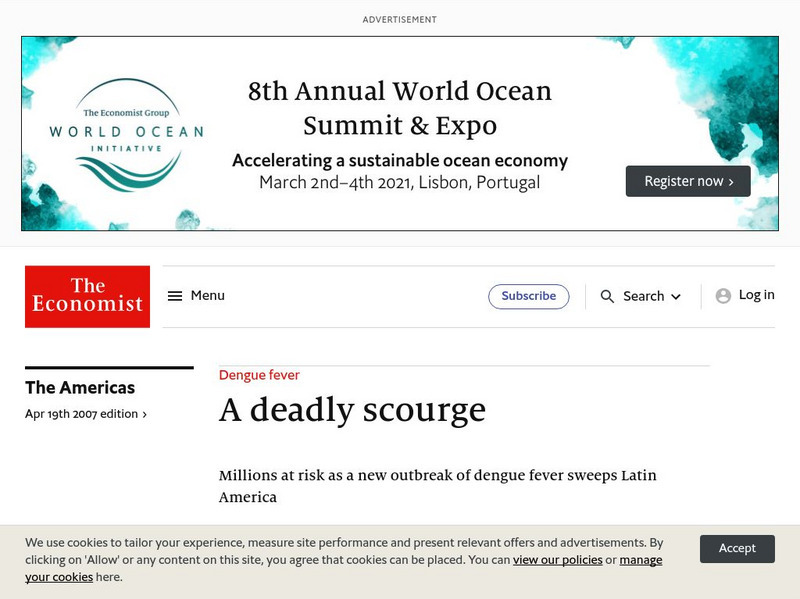Hi, what do you want to do?
Curated OER
West Nile Virus-What is the Risk?
Begin with an online pre-quiz about West Nile Virus. Using a fictional scenario, young epidemiologists read how it is transmitted and examine the stages of the life cycle of a mosquito. They imagine that they are members of the Centers...
Curated OER
West Nile Virus Strikes Again
Students examine the West Nile virus and how it is impacting an American Indian reservation, In this virus instructional activity students devise a prevention plan for an Indian reservation to help limit the transfer of the West...
Curated OER
Stories of Hope: Dragonfly and Mosquito
Students identify and interpret the value of the dragonfly as a predator of the mosquito. They create their own folktales using the dragonfly or a creature of their choice to solve the malaria problem or another issue. Students also...
Curated OER
The Use of Myths in Science
Learners are told stories, myths and legend to explain their world. After telling the tales and discussion them, students are assigned to write a myth that describes a familiar situation, such as why the school garbage cans are always...
Curated OER
Mosquito Life Cycles
Students gather mosquito eggs to record the mosquito life cycle using drawings, descriptions, and any other appropriate means. In small groups, they analyze and describe the process of complete metamorphosis. They classify mosquitoes...
Curated OER
Mosquito Bites
Students examine malaria. In this malaria lesson plan, students visit selected websites to watch videos and read information about how malaria is spread and how it can be prevented. Students use their...
Curated OER
Adopt-An-Insect
In this biology worksheet, middle schoolers locate examples of various types of insects listed in the chart and receive a point value for each according to its significance. Then they identify body parts and habitat for each item.
University of Virginia
Medical History: Yellow Fever and Walter Reed
Photographs and documents from the University of Virginia's Hench-Reed Collection tell the story of the work done in Cuba at the turn of the 20th century toward finding the cause of Yellow Fever. Hyperlinks to additional information.
Language Guide
Language Guide: Los Insectos
Colorful pictures display various types of insects. You can hear the correct Spanish pronunciation and see the correct spelling by holding your mouse over the picture.
Canadian Wildlife Federation
Hinterland Who's Who: Mosquito
Get the facts about mosquito. Besides finding a detailed description of these pesky insects, you'll also learn about some of their unique facts and characteristics. Also included in this Insect Fact Sheet on mosquitoes is information on...
Enchanted Learning
Enchanted Learning: Mosquito
An illustrated diagram of the Anopheles mosquito. Get detailed information on its life cycle, mosquito bites, and more.
Other
Tom Moore, Mulrennan Research Center/ Mosquito
The first section describes the general characteristics of the mosquito
Rutgers University
Rutgers University: Mosquito Biology
You can find some great diagrams and basic information about mosquitoes in these pages from the New Jersey Mosquito Control Association. Although it is state specific, the information is valuable for anyone looking at mosquitoes.
University of Wisconsin
The Why Files: Mosquito Bytes
The Why Files have provided an informative site regarding mosquitos. Included in this resource is information pertaining to reproduction, life cycle, disease caused, and repellent advice.
University of Wisconsin
The Why Files: Mosquito Bytes
Everything you might need to know about mosquitos can be found here. The lesson plan includes a lab that investigates the effect of temperature on mosquito egg development.
Other
Frontline: Zika Uncontained
A comprehensive news report about the Zika virus in Brazil. Zika is a serious concern because of how rapidly it is spreading throughout the world and the dangers it brings.
Iowa State University
Iowa State University: Iowa Insect Information Notes Mosquitoes
Mosquitoes are universally considered pests and they can carry dangerous parasites that can make people sick. This article is about controlling mosquitos around the home.
World Health Organization
World Health Organization: Can Tiny Bacteria Help Stop the Spread of Disease?
An innovative initiative is taking place in Brazil where researchers are employing mosquitos to help prevent the spread of deadly mosquito-spread diseases. Understand the study taking place.
Other
What a Mosquito's Immune System Can Tell Us About Fighting Malaria
Scientists are studying how mosquitos are able to fight off the parasites that humans seem to be unable to battle. Research is being done to help understand what slows or stops these parasites in the mosquito to protect them in an effort...
Mayo Clinic
Mayo Clinic: Encephalitis
This site from the MayoClinic.com provides a great look at the acute inflammation of the brain caused by a viral infection known as encephalitis. Sections in the article include: signs and symptoms, causes, screening, treatment,...
Other
American Mosquito Control Association: Mosquito Life Cycle
Learn about the life cycle of mosquitos, from the egg to adulthood, including the environment necessary for each stage.
BBC
Bbc News: Mosquitoes 'Disappearing' in Some Parts of Africa
Science news article describes the decline in mosquito populations across Africa and the possible ramifications of these events. (August, 2011)
The Economist
The Economist: Dengue Fever: A Deadly Scourge
This article describes the growing epidemic of dengue fever, or DHF, in Mexico and other tropical areas. The virus is caused by mosquitos.
The Economist
The Economist: Dengue Fever: A Deadly Scourge
This article describes the growing epidemic of dengue fever, or DHF, in Mexico and other tropical areas. The virus is caused by mosquitos. Registration is required.




























